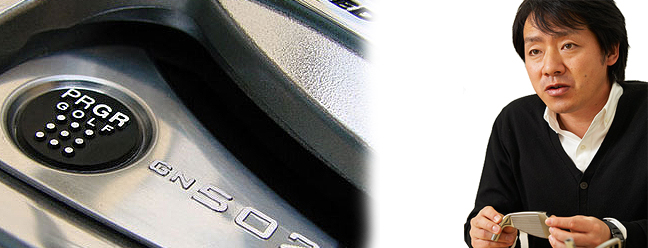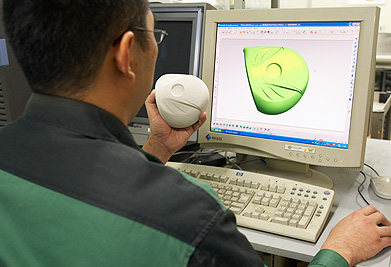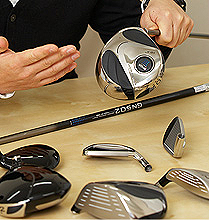
 Pro Gear recently featured a report done in collaboration with top designer Ryo Yashiro from the Yokohama Rubber Hiratsuka factory.
Pro Gear recently featured a report done in collaboration with top designer Ryo Yashiro from the Yokohama Rubber Hiratsuka factory.
The massive R&D department that PRGR ( Pro Gear ) features has every top swing analysis system including their own PRGR science fit. The PRGR science fit is a unique system and the only one of it’s kind that measures grip speed and torso turn which creates power and speed from the large muscles instead of the end resut which is club head speed and spin rates.
Over the years Yashiro san has accumulated data from Professional and Amatuer golfers who visited as part of the R&D program. This lead to the creation of their newest line the GN502 series. Please keep in mind this is not the GN502 Tour Driver or GN502 Forged Model. This is the standard GN502 that is aimed to help improve the game of 70% of all golfers.
Ryo Yashiro goes on to say:
First I aimed to monitor the golfers grip speed. There isn’t much data that explains the body turn type and where the hands are in relation to the torso. The type of golfer that has an early and loose release type increases the side spin left to right creating a slice and losing carry. The ball flight is also very unstable and inconsistent. What kind of club should be designed for such a player to be able to meet the face with the ball square at impact? I then began working on a plan that includes the visual effect as well as the shape, function and Technology.
The Goal:
Creating a club that is square more often at impact than others for all types of golfers from Professional to Amatuer. Let’s face it many golfers even after decades of playing the sport we love so much are still unable to square the face at will. So PRGR started from the pure basics of the body before working their way to the design of the club.
 The Design:
The Design:
The weight location of the GN502 driver was produced to be longer from front to back. The volume in certain areas needed to be increased to get tht golfer with an Early release more force, the combonation of those fine adjustments show a substantial aid in making the club head square at impact.
Fairway Woods:
So the question was asked ” What kind of 3 wood helps the 70% of golfers who have an early release tendency? Based on thousands of questionares the most desired attributes of a 3W is ease of getting the ball into the air, pull’s, slices, and weak or missed shots. Yashiro based the design of the GN502 Hit Fairway wood on the ability to lift the ball with ease off of the ground and helping the head square at impact for the early release player. These are the two largest complaints found on the questionare direction and trajectory. The end result was a shallow face for increased height, Maraging steel face and light weight thin crown saving 12 grams. The implementation of a heavy tungsten sole was added setting the center of gravity location to 23mm which is very low for a 3W.
 GN502 Irons:
GN502 Irons:
When 70% of golfers share a similar swing pattern the technology shared in the woods will also help the irons. The feedback report showed that the majority of Japanese golfers desire a forged material. Considering the average ball’s center of gravity is about 21mm the iron should be designed to meet and match it with it’s own center of gravity placement to enhance the result and create the proper amount of spin and height on the shot.
The GN502 Iron design uses a resin structure inserted under the top blade of the ( 3-9I ) This gave Yashiro a margin of 5 grams which was exactly the amount needed to create a more desired result during play. In the standard version GN502 iron geared more to the average golfer they used a maraging steel face like the FW and combined with the resin insert you gain velocity and a sense of soft feel.
Yashiro says:
“It’s also the weight (the distance) flow design which is made inside the cavity set thickness deviation while keeping height of the gravitational centre as the whole gage at 20mm. The head tends to be returned to a long iron, and a ball can be caught dead center more frequently. While the short iron is designed without that feature for a more intentional result.
So there it is in a nutshell guy’s and gal’s A breif but fairly informative breakdown of PRGR’s design philosiphy with regards to the GN502 Series of Clubs. Sounds to me like they are trying very hard to fix the issue of an early release in the golfers swing. Please keep in mind this isnt the same design used in the GN502 Tour/Forged Model. The Tour Model is designed for the better player. To learn more about the product please visit the TSG ProShop by Clicking Here…












I see that you say that your department has every top swing analysis program – which systems were they tested on?
Hi Cory, Tourspecgolfer was referring to PRGR’s deparment not ours. PRGR as a golf manufacturer uses all kinds of monitors including trackman, vector as well as their own Science Fit which is a very advanced program that tracks the complete path of the swing from take back to follow though as well as the speed generated at different points of the swing.
Any major differences between this model and the 501/502 predecessors? Also, how are the PRGR stock shafts? Do they make these internally?